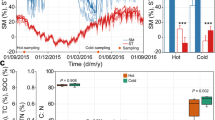Abstract
Cryogenic ecosystems are crucial elements of the biosphere, acting as a repository of organic matter on a global scale. However, recent trends in average annual temperatures increasing in these regions are leading to rapid permafrost thaw and promoting the release of organic carbon through microbial degradation and further methane emission into the atmosphere. The methanogenic and methanotrophic microbial communities are the key elements of the methane cycle. We studied associations of methanotrophs with mosses, lichens, and algae in subpolar ecosystems, with the maritime climate since the process of permafrost thawing is most pronounced in coastal areas. In incubation experiments, the methane-oxidizing capacity of methanotrophs associated with cryptogamic communities growing in tundra ecosystems of the Lena River Delta (Yakutia) and King George Island (South Antarctica) was measured. It has been shown, that moss and lichen associates of the studied subpolar ecosystems have a pronounced methanotrophic activity. In addition, increasing moisture changed the methanotrophic ability of the Antarctic cryptogamic communities to the methanogenic one.
Access this chapter
Tax calculation will be finalised at checkout
Purchases are for personal use only
Similar content being viewed by others
References
Hugelius, G. et al., 2014. Estimated stocks of circumpolar permafrost carbon with quantified uncertainty ranges and identified data gaps. Biogeosciences. 11: 6573–6593 (2014).
Conrad, R., 2007. Microbial ecology of methanogens and methanotrophs. Adv. Agron. 96:1–63.
Oremland, R.S., Zehnder, A.J.B., 1988. Biogeochemistry of Methanogenic Bacteria. Wiley: New York, NY, USA, 641–705.
Lacis, A., Hansen, J., Lee, P., Mitchell, T., and Lebedeff, S., 1981. Greenhouse effect of trace gases, 1970–1980. Geophys. Res. Lett. 8:1035–1038.
Hansen, J., Sato, M., Ruedy, R., Lacis, A., and Oinas, V., 2000. Global warming in the twenty-first century: An alternative scenario. Proc. Natl. Acad. Sci. USA. 97:9875–9880.
Knoblauch C. et al., 2018. Methane production as key to the greenhouse gas budget of thawing permafrost. Nature Climate Change. T. 8. – №. 4:309–312.
Chen, Y. H., and Prinn, R. G., 2005. Atmospheric modeling of high and low frequency methane observations: Importance of interannually varying transport. Journal of Geophysical Research, 110.
Reeburgh, W. S. et al., 2003. Global methane biogeochemistry. In ‘‘Treatise on Geochemistry: The Atmosphere’’. Elsevier-Pergamon, Oxford, UK. 4:65–89.
Knief C., Lipski A., Dunfield P.F., 2003. Diversity and activity of methanotrophic bacteria in different upland soils. Appl. Environ. Microbiol. 69: 6703–6714.
Hanson R. S., Hanson T. E., 1996. Methanotrophic bacteria. Microbiological reviews. T. 60. №. 2:439–471.
Tyurin V.S., Gal'chenko V.F., 1976. Submicroscopic structure of the membrane apparatus of methanotrophic bacteria. Microbiology. V. 45. № 3 P. 503–506. (in Russian)
Galchenko V.F., 2011. Methanotrophic bacteria // M.: GEOS. P. 500 p. (in Russian)
Trotsenko Yu.A., Khmelenina V.N., 2008. Extremophilic methanotrophs. Pushchino: ONTI PSC RAS. P. 206. (in Russian)
Knoblauch, C., O. Spott, S. Evgrafova, L. Kutzbach, and E.-M. Pfeiffer., 2015. Regulation of methane production, oxidation and emission by vascular plants and bryophytes in ponds of the northeast Siberian polygonal tundra. J. Geophys. Res. Biogeosci. 120:2525–2541.
Danilova O.V., Dedysh S. N., 2014. Abundance and diversity of methanotrophic Gammaproteobacteria in northern wetlands. Microbiology. Vol. 83. Issue 1–2: 67–76.
Stępniewska Z., Goraj W., Kuźniar A., Szafranek-Nakonieczna A., Banach A., Górski A., Pytlak A., Urban D., 2018. Methane oxidation by endophytic bacteria inhabiting Sphagnum sp. and some vascular plants, Wetlands. Vol. 38. Issue 3: 411–422.
Putkinen A., Tuittila E.S., Siljanen H.M., Bodrossy L., Fritze H., 2018 Recovery of methane turnover and the associated microbial communities in restored cutover peatlands is strongly linked with increasing Sphagnum abundance. Soil Biology and Biochemistry. Vol. 116:110–119.
Belova, S.E.; Danilova, O.V.; Ivanova, A.A.; Merkel, A.Y.; Dedysh, S.N., 2020. Methane-oxidizing communities in lichen-dominated forested tundra are composed exclusively of high-affinity USCα methanotrophs. Microorganisms. 8:2047.
Ho A., Lee H.J., Reumer M., Meima-Franke M., Raaijmakers C., Zweers H., de Boer W., Van der Puttend W.H., Bodelier P.L., 2019. Unexpected role of canonical aerobic methanotrophs in upland agricultural soils. Soil Biology and Biochemistry. Vol. 131:1–8.
Acknowledgements
The work was carried out with the financial support of the RSF grant No. 21-17-00163. The authors are grateful to the Russian Antarctic Expedition for the comprehensive assistance and support.
Author information
Authors and Affiliations
Corresponding author
Editor information
Editors and Affiliations
Rights and permissions
Copyright information
© 2023 The Author(s), under exclusive license to Springer Nature Switzerland AG
About this paper
Cite this paper
Kadutskiy, V.K. et al. (2023). Methanotrophic Ability of Cryptogamic Communities of Coastal Ecosystems. In: Karev, V.I. (eds) Physical and Mathematical Modeling of Earth and Environment Processes—2022. PMMEEP 2022. Springer Proceedings in Earth and Environmental Sciences. Springer, Cham. https://doi.org/10.1007/978-3-031-25962-3_29
Download citation
DOI: https://doi.org/10.1007/978-3-031-25962-3_29
Published:
Publisher Name: Springer, Cham
Print ISBN: 978-3-031-25961-6
Online ISBN: 978-3-031-25962-3
eBook Packages: Earth and Environmental ScienceEarth and Environmental Science (R0)




